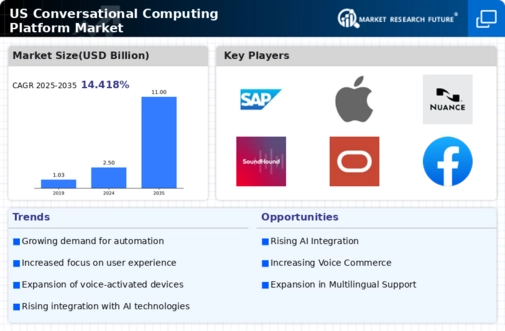Rising Adoption of Remote Work Solutions
The rise of remote work solutions is reshaping the conversational computing-platform market. As organizations adapt to flexible work environments, the need for effective communication tools has become paramount. The market for remote work technologies is anticipated to grow by 30% in the next few years, with conversational platforms playing a crucial role in facilitating collaboration among distributed teams. These platforms enable seamless communication, allowing employees to interact efficiently regardless of their location. The shift towards remote work is likely to drive the adoption of conversational computing solutions, as businesses seek to maintain productivity and engagement in a virtual setting. This trend underscores the importance of conversational platforms in supporting modern work practices.
Emergence of Multilingual Support Features
The emergence of multilingual support features is becoming increasingly relevant in the conversational computing-platform market. As businesses expand their reach globally, the ability to communicate in multiple languages is essential for effective customer engagement. Platforms that offer multilingual capabilities are likely to attract a broader user base, enhancing their competitive edge. Recent studies indicate that companies utilizing multilingual conversational solutions experience a 15% increase in customer satisfaction. This trend is particularly significant in diverse markets, where language barriers can hinder communication. By incorporating multilingual support, conversational platforms can cater to a wider audience, thereby driving growth in the market. The focus on inclusivity and accessibility is expected to shape the future of conversational computing solutions.
Advancements in Natural Language Processing
Advancements in natural language processing (NLP) are significantly influencing the conversational computing-platform market. Enhanced NLP capabilities allow platforms to understand and respond to user queries more accurately, leading to improved user experiences. As of November 2025, the market for NLP technologies is estimated to reach $15 billion, with a substantial portion allocated to conversational platforms. These advancements enable businesses to automate customer interactions, reducing operational costs while increasing efficiency. Furthermore, the integration of machine learning algorithms enhances the ability of platforms to learn from interactions, thereby improving their performance over time. This evolution in NLP technology is likely to attract more businesses to adopt conversational computing solutions, further driving market growth and innovation.
Increased Investment in Digital Transformation
The ongoing trend of digital transformation across various industries drives the conversational computing-platform market. Organizations are investing heavily in technology to streamline operations and enhance customer interactions. In 2025, it is projected that companies will allocate approximately $2 trillion towards digital transformation initiatives, with a significant portion directed towards conversational computing solutions. This investment reflects a strategic shift towards leveraging technology to improve efficiency and customer engagement. As businesses seek to modernize their operations, the demand for conversational platforms is expected to rise, creating new opportunities for market players. The focus on digital transformation is likely to sustain the growth trajectory of the conversational computing-platform market in the coming years.
Growing Demand for Customer Engagement Solutions
The conversational computing-platform market is witnessing a surge in demand for customer engagement solutions. Businesses are increasingly recognizing the value of real-time communication with customers, which enhances satisfaction and loyalty. According to recent data, companies that implement conversational platforms report a 20% increase in customer retention rates. This trend is driven by the need for efficient customer service and the desire to provide personalized experiences. As organizations strive to differentiate themselves in a competitive landscape, the adoption of conversational computing platforms becomes essential. The market is projected to grow at a CAGR of 25% over the next five years, indicating a robust shift towards these technologies. This growth reflects a broader trend where businesses prioritize customer-centric strategies, thereby propelling the conversational computing-platform market forward.

















Leave a Comment